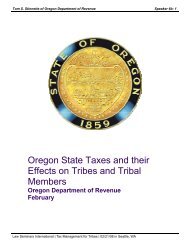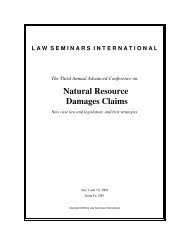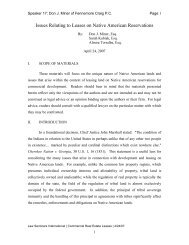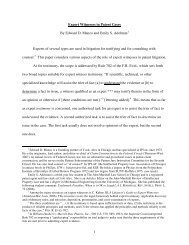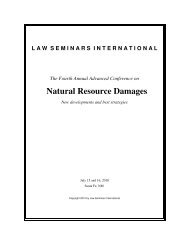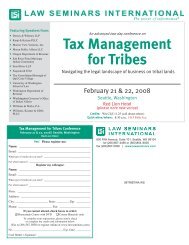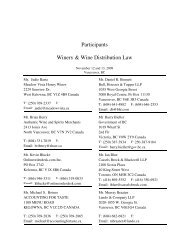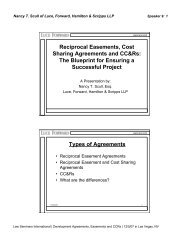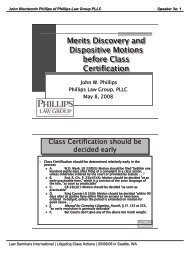LSI 2010 Real Estate Joint Ventures conference materials.pdf
LSI 2010 Real Estate Joint Ventures conference materials.pdf
LSI 2010 Real Estate Joint Ventures conference materials.pdf
Create successful ePaper yourself
Turn your PDF publications into a flip-book with our unique Google optimized e-Paper software.
Brian Todd of Davis Wright Tremaine LLP<br />
Andrew H. Zuccotti of K&L Gates LLP<br />
alternate test for economic effect.<br />
Speaker 11: 5<br />
Speaker 12: 5<br />
E. Substantiality. The second prong of the substantial economic effect safe<br />
harbor requires that the economic effect of an allocation be “substantial.” Under the<br />
regulations, the economic effect of an allocation of profit or loss will be substantial, and<br />
be respected, if there is a reasonable possibility that the allocation will affect substantially<br />
the dollar amounts to be received by the partners or members from the partnership or<br />
LLC, independent of tax consequences. The focus here is on whether the after-tax<br />
consequences of at least one partner or member will (in present value terms) be enhanced<br />
by receiving the allocations in the partnership or LLC agreement without a concomitant<br />
effect on the after-tax economic consequences of any other partner or member. If so,<br />
then the allocation may not be substantial.<br />
F. Failure to Satisfy the Substantial Economic Effect Test – the “No Harm,<br />
No Foul” Rule. Even if allocations made to a member or partner do not have “substantial<br />
economic effect” because the partnership or LLC agreement does not contain the<br />
provisions required to satisfy the economic effect test, the regulations nonetheless will<br />
deem the allocations to have economic effect if, as of the end of each partnership or LLC<br />
taxable year a liquidation of the partnership or LLC at the end of such year or at the end<br />
of any future year would produce the same economic results to the partners or members<br />
as would occurs if the economic effect requirements were satisfied. It is this provision<br />
that drafters of LLC and partnership agreements using the targeted capital account<br />
approach, discussed below, rely upon for comfort that allocations made under the<br />
agreement will be respected.<br />
G. Failure to Satisfy the Substantial Economic Effect Test – the Partners’<br />
Interest in the Partnership Test. If a partnership or LLC agreement provides for an<br />
allocation of profits or losses that does not satisfy the substantial economic effect safe<br />
harbor, and the “no harm, no foul rule” cannot be said to apply, the IRS may reallocate<br />
profits and losses in accordance with the partners’ or members’ interests in the<br />
partnership or LLC—that is, in accordance with the manner in which the partners or<br />
members have agreed to share the economic benefit or burden (if any) corresponding to<br />
the profit or loss allocation that does not have substantial economic effect. A partner’s or<br />
member’s interest in the partnership or LLC will be determined based upon all of the<br />
facts and circumstances, including the partners’ or members’ relative contributions to the<br />
partnership or LLC, the interests of the partners or members in economic profits and<br />
losses (if different than their interests in taxable income or loss), the interests of the<br />
partners or members in cash flow and other non-liquidating distributions and the rights of<br />
the partners or members to distributions of capital on liquidation.<br />
II.<br />
Drafting Financial Provisions of a Partnership or LLC Agreement.<br />
A. Overview. In general there are currently two primary methods of drafting<br />
the financial provisions of a partnership agreement or an LLC operating agreement.<br />
These typically are referred to as: (i) liquidation by capital account balances and (ii)<br />
liquidation by specified tiers with target allocations. The draftsman using the liquidationby-capital-accounts<br />
method uses allocations of profit and loss to construct capital<br />
DWT 12372832v1 0053770-000001<br />
Law Seminars International | <strong>Real</strong> <strong>Estate</strong> <strong>Joint</strong> <strong>Ventures</strong> and Funds | 02/08/10 in Seattle, WA




